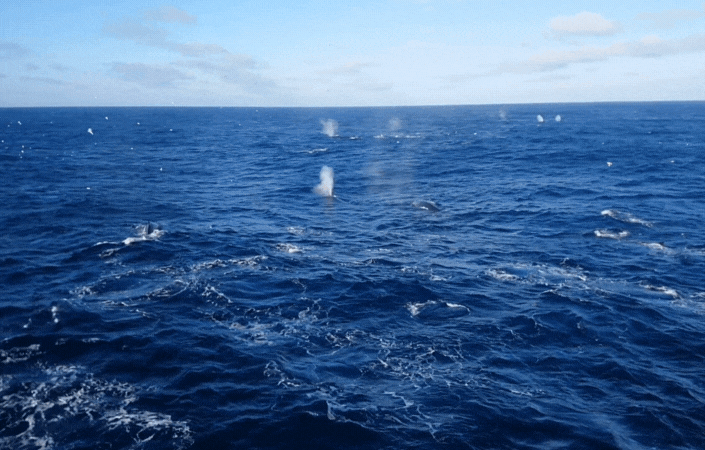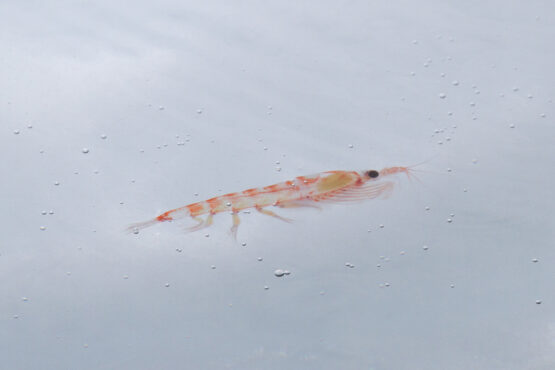Trawlers working amidst a whale ‘supergroup’ raise red flag about human-whale conflicts in a changing ocean, Stanford study says
Scientists observed close to 1,000 fin whales foraging near Antarctica, while fishing vessels trawled for krill in their midst. Without action, such encounters are likely to become more common as this endangered species recovers and krill harvesting intensifies in the Southern Ocean.
Once driven nearly to extinction, the second-largest animals of all time have recently been spotted in big numbers in the Southern Ocean, competing directly with industrial trawlers for prey, according to research led by scientists from Stanford University and Lindblad Expeditions.

Fin whales surround the research vessel National Geographic Endurance in January 2022. (Image credit: Video by Conor Ryan)
Published Feb. 20 in Ecology, the study focuses on scientists’ sighting of an enormous “supergroup” of fin whales foraging for shrimplike animals called krill northwest of the South Orkney Islands in January 2022, with four commercial fishing vessels trawling among them for the same tiny creatures.
The researchers, led by Matthew Savoca of Stanford and Conor Ryan of Lindblad Expeditions, estimate at least 830 and possibly more than 1,100 fin whales were present. This ranks among the largest groups of baleen whales ever recorded since commercial whaling decimated their populations last century.
The epicenter of a booming industry
The authors recorded video of the whale supergroup – as well as two humpback whales, a blue whale, Antarctic fur seals, and thousands of seabirds – from 40 feet above sea level, capturing 71 square miles of an area that the authors call “the global epicenter of krill fishing.” They later used the video to count how many blows occurred simultaneously at the water’s surface (143) and track how long each blow lasted (about five to 11 seconds). With these data, they then estimated the total group size. “I’ve never witnessed anything close to the scale of this gathering of fin whales,” said Ryan, a research scientist with Lindblad who has been studying the species for 20 years.

Fishing vessels harvest krill among nearly 1000 fin whales off the coast of Coronation Island, South Orkney. Hundreds of seabirds including albatrosses and petrels can be seen among the whale blows. (Image credit: Video by Eric Wehrmeister)
The scene would have been hard to imagine just a few decades ago. “While there are indications that the Southern Ocean whale population is slowly recovering, we should not take this rebound for granted. These whales, and the ecosystems they rely on, face increasing pressures from commercial fishing and climate change,” said study co-author Earle Wilson, assistant professor of Earth system science at the Stanford Doerr School of Sustainability. “This work raises serious concerns about krill harvesting in the Southern Ocean and whether existing environmental policies are sufficient to ensure the long-term health of these whales.”
No restrictions are currently in place for how the commercial fisheries interact with – or avoid – whales while fishing for krill, said Savoca, who is a postdoctoral scholar in the Goldbogen Lab at Hopkins Marine Station, Stanford’s marine laboratory on the Monterey Peninsula. “It is perfectly legal for massive industrial super-trawlers to seek out whales to find krill, then harvest the whales’ bounty while dragging large trawl nets through the water to do so,” he said. “This is what we observed and reported on in this paper.”
For whales, interactions with fishing vessels present dangers from ship strikes and entanglement in nets. Whales may also suffer indirect effects from fishing boats finding and harvesting the densest patches of krill, which fin whales rely on almost entirely for food. Previous research from Savoca and Jeremy Goldbogen, an associate professor of oceans at Stanford, has concluded there is no longer enough krill in the Southern Ocean to support recovery of whale populations to pre-whaling numbers, even in the absence of krill fishing. “The solution is to include whales in the fishery management plan,” Savoca said.
Departure from old patterns
One of the most abundant species on Earth, Antarctic krill play a critical role in fertilizing the world’s oceans and making the Southern Ocean one of the planet’s largest carbon sinks – in addition to providing food for wildlife. In U.S. waters, NOAA has banned krill harvesting within 200 miles of the nation’s Pacific coast since 2009 based on their importance to the marine ecosystem.

Antarctic krill, drifting with an iceberg in Port Charcot, Antarctic Peninsula. (Image credit: Conor Ryan)
The krill industry has boomed in recent years, however, in the Southern Ocean, where fishing is regulated by the Commission for the Conservation of Antarctic Marine Living Resources, an international commission that makes rules by consensus. Among the main drivers for the boom are rising demand for krill as dietary supplements and feed for farmed fish like salmon, while technological advances have made fishing boats even more efficient at harvesting krill. Another important factor has been greater access due to the decline of Antarctic sea ice, which hit a historic low this month, breaking a record set only last year.
The January 2022 sighting of hundreds of fin whales and four trawlers was at the tail end of a large spring bloom of phytoplankton, the tiny algae eaten by krill that form the base of the ocean food web.
The convergence of this bloom with a vast krill swarm and supergroup of foraging whales represents a departure from old patterns. Before krill fishing took off, whales and phytoplankton blooms rarely overlapped, possibly because large swarms of grazing krill kept blooms in check. That dynamic may be disrupted, and should be closely monitored, the authors say, if fishing vessels continue to harvest krill by the ton from the same swarms where whale supergroups feast.
“Under the present scenario of increasing whale densities and krill fishing effort, whale-fishery interactions, including bycatch, are likely to increase unless action is taken,” the authors write.
Wilson is also an assistant professor, by courtesy, of geophysics and of oceans at the Stanford Doerr School of Sustainability, and a center fellow, by courtesy, at the Stanford Woods Institute for the Environment. Additional co-authors are affiliated with Lindblad Expeditions, the Institute for Marine and Antarctic Studies at the University of Tasmania, Eco-Vista: Photography & Research, and the University of Washington.
This research was supported by MAC3 Impact Philanthropies.
To read all stories about Stanford science, subscribe to the biweekly Stanford Science Digest.
